Birding in Senegal
21 April 2020 · Remco Hofland · 9847 × bekeken
This article is an excerpt from a full tripreport to be published on Cloudbirders.com soon.
Visited sites (in chronological order) from 22 February to 1 March, 2020.
Richard Toll, [skipped Podor], Ross Béthio, Djoudj, Tres Marigots, Saint-Louis, Dabaye (large vultures), Darou Mousty (Sahel Paradise-Whydah), Touba (Quail-plover), Kousmar island, Toubakouta, Saloum delta, Lagune de Somone (Saly).
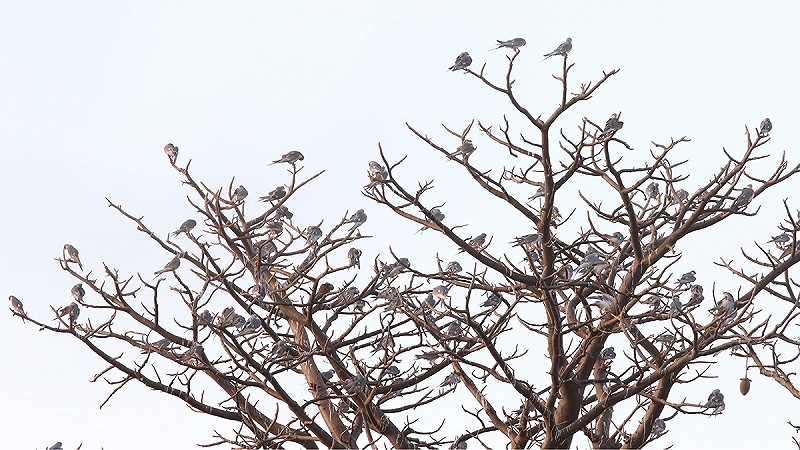 Scissor-tailed Kites Chelictinia riocourii, Kousmar Island, Senegal, 27 February 2020 (Vincent Hart)
Scissor-tailed Kites Chelictinia riocourii, Kousmar Island, Senegal, 27 February 2020 (Vincent Hart)
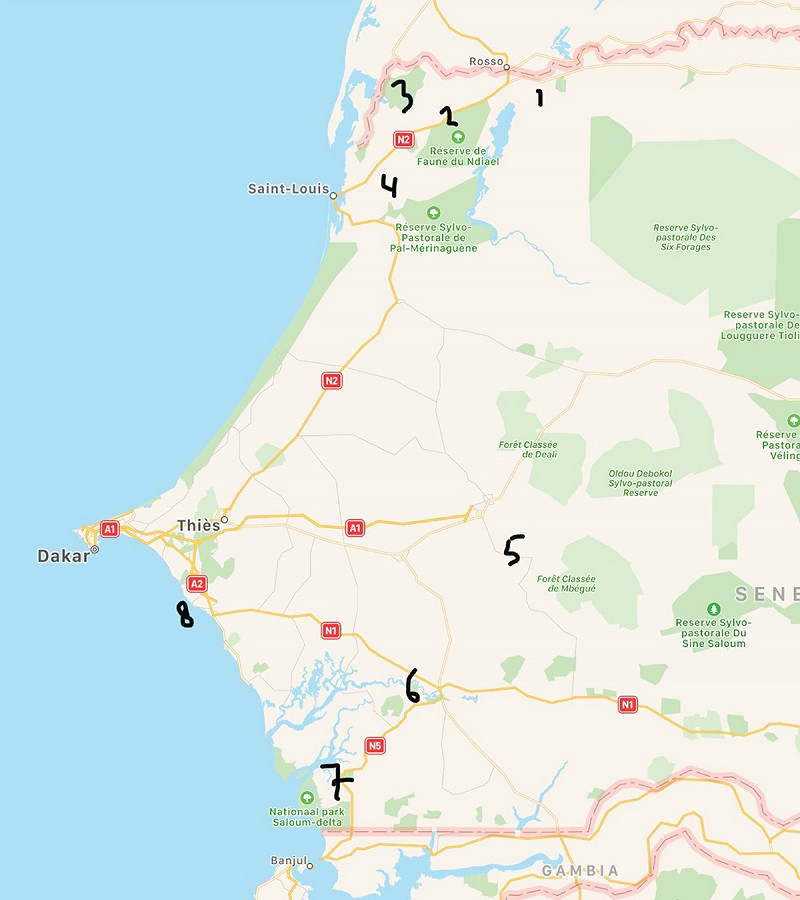 1 Richard Toll, 2 Ross Béthio, 3 Djoudj, 4 Tres Marigots, 5 Quail-plover site, 6 Kousmar island, 7 Toubakouta, 8 Lagune de Somone (Saly), Senegal, 20 February 2020 (Remco Hofland)
1 Richard Toll, 2 Ross Béthio, 3 Djoudj, 4 Tres Marigots, 5 Quail-plover site, 6 Kousmar island, 7 Toubakouta, 8 Lagune de Somone (Saly), Senegal, 20 February 2020 (Remco Hofland)
Participants
Johan van ‘t Bosch, Vincent Hart, Remco Hofland and Bertus de Lange.
Introduction
Senegal came onto our radar because of its large Scissor-tailed Kite roost. A lifer for two of us, we all wanted to witness the phenomenon of one of the most beautiful raptors in the world dropping from the sky in large numbers. We saw possibilities to combine this with some other highly desirable, localised species: White-crested Tiger Heron, River Prinia, Arabian & Savile’s Bustard and Black-headed Weaver; as well as Sahelian specialties found most easily here in Senegal: most importantly the enigmatic Quail-plover, as well as Golden Nightjar, Little Grey (Sahelian) Woodpecker, Cricket Warbler, Sennar Penduline-Tit, Sahel Paradise-Whydah and Chestnut-bellied Starling. As Bertus is a teacher, we had to limit ourselves to his one-week February holiday – but fortunately TAP flights Amsterdam-Lisbon-Dakar vice versa allowed us to spend Sat until Sun (nine full days) in the field. As it turned out, Senegal had a lot more to offer, most importantly huge numbers of wintering birds (mainly at Djoudj) and a wide array of West African birds – in all, a most enjoyable experience during which we saw all our targets.
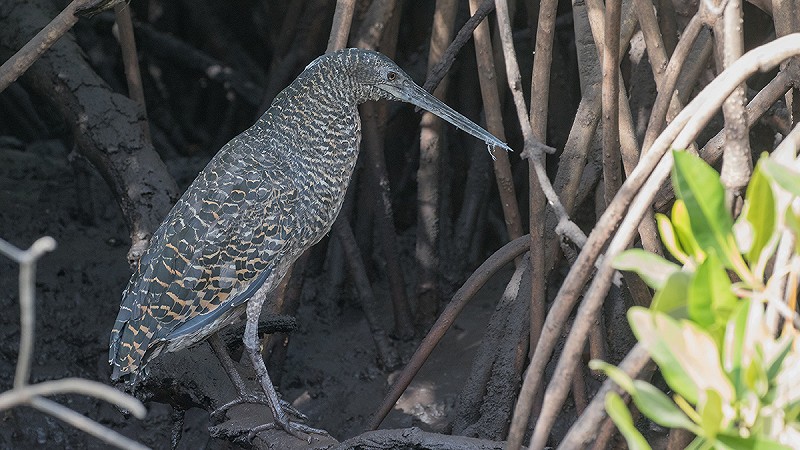 White-crested Tiger Heron Tigriornis leucolopha, Saloum Delta, Senegal, 28 February 2020 (Johan van 't Bosch)
White-crested Tiger Heron Tigriornis leucolopha, Saloum Delta, Senegal, 28 February 2020 (Johan van 't Bosch)
Timing of trip
Our visit was timed during the Dutch (one-week) February holiday. Most birders visit Senegal between November and early March, when the Scissor-tailed Kites roost every night in the baobab trees of Kousmar island near Kaolack. In Nov-Dec numbers are said to be in the 10,000’s but, although videos taken around that time surely show numbers much higher than we witnessed (500+ kites and 200+ Lesser Kestrels), in fact accurate numbers are hard to obtain. Since Kousmar island is several km² large and the baobabs in which the birds roost are spread over the island, one needs quite a few counters to do a simultaneous count in order to obtain reliable numbers.
Most of the other specialties mentioned in Introduction are found in Senegal throughout the year, although the Black Crowned Cranes we saw many of at Djoudj are said to migrate to Casamance in summer to breed. The added attraction of a winter trip are the large numbers of wintering wildfowl, as well as waders, Eurasian Spoonbills, harriers and passerines originating from the northern Western Palearctic.
Highlights
Not even did we see all targets mentioned under Introduction, but we found all targets very quickly, and saw them very well. Besides 500+ Scissor-tailed Kites (and 200+ Lesser Kestrels) at Kousmar island, a Quail-plover at 12m, a White-crested Tiger Heron at 5m (for over half an hour), two Golden Nightjars at 5m during the day, two Arabian & 10+ Savile’s Bustard sightings, Little Grey (Sahelian) Woodpecker, River Prinia, Sennar Penduline-Tit, Sahel Paradise-Whydah and Chestnut-bellied Starling; there were other highlights in the form of flocks of c 20,000 male Garganey, c 20,000 Northern Pintail and four Marbled Duck at Djoudj; Long-tailed Nightjar, Chestnut-bellied & Four-banded Sandgrouse, Allen’s Gallinule, Baillon’s Crake (a lifer for guide Abdou), dozens of Black Crowned Crane & Greater Painted Snipe, a flushed Great Snipe, Temminck’s Courser, Audouin’s Gull, Goliath Heron, Rüppell’s, African White-backed & Lappet-faced Vultures (all these present in a flock of c 40 large vultures on a dead cow), Bateleur, African Hawk-Eagle, many male Montagu’s and a few Pallid Harriers, roosting Barn and Verreaux’s Eagle-Owl, Black Scimitarbill, Blue-bellied Roller, Blue-breasted Kingfisher, Bearded Barbet, Blue-cheeked Bee-eater, Eurasian Wryneck, Fine-spotted Woodpecker, Red-necked Falcon, Senegal Batis, Brown-throated Wattle-eye, White-crested Helmetshrike, Black-crowned & Chestnut-backed Sparrowlark, Oriole Warbler, Fulvous Babbler ssp buchanani, Yellow-billed Oxpecker, Black Scrub Robin, Mangrove (Mouse-brown) Sunbird, 1,000+ Sudan Golden Sparrow, Black-headed Weaver, Lavender and Orange-breasted Waxbill and Quailfinch.
River Prinia Prinia fluviatilis, Djoudj, Senegal, 23 February 2020 (Remco Hofland)Non-feathered highlights were four species of primates: Green Chlorocebus sabaeus and Patas Monkey Erythrocebus patas, Temminck’s Red Colobus Piliocolobus temminckii and Guinea Baboon Papio papio; several African Golden Wolf Canis anthus anthus and Common Warthog Phacochoerus africanus at Djoudj; Four-toed Hedgehog Atelerix albiventris, Gambian Epauletted Fruit Bat Epomophorus gambianus; Nile Crocodile Crocodylus niloticus, Nile Monitor Varanus niloticus, Gambian Tarentola senegambiae & Sierra Leone Wall Gecko T. parvicarinata, Uganda Dwarf Gecko Lygodactylus gutturalis; Christmas Butterfly Papilio demodocus, Desert Babul Blue Azanus ubaldus; Blue Basker Urothemis edwardsii – and watching 10,000’s of Vagrant Emperors Anas ephippiger moving north was also a fantastic sight.
Trip totals
We recorded 290 birds, which were all seen; this total includes one introduced species (House Sparrow). I saw 13 lifers (all specialties mentioned under Introduction minus Scissor-tailed Kite & Arabian Bustard (seen in Ethiopia) and White-crested Tiger Heron (seen in Ghana), plus Greater Swamp Warbler, Yellow-throated Leaflove and White-rumped Seedeater); Bertus saw 14 lifers, Vincent 22 and Johan c 40.
Dips
We searched for Yellow Penduline-Tit in the Toubakouta area but failed to find it. At coastal sites Saint-Louis and Lagune de Somone we looked for the pallid (sub)species of Grey Heron Ardea cinerea monicae (that originates from the Banc d’Arquin in Mauritania and was seen once at Saint-Louis) and Kelp Gull but we saw neither.
Guide
We used the services of excellent bird guide Abdou Lo (aka Carlos).
Abdou lives in Toubakouta and has been birding since 2008. He is fluent in English, French and Spanish. He used to be a general guide in the Toubakouta area but his interest in nature led him to become a birder and bird guide. His usual season as a bird guide is from October to April, during which he so far had few clients / groups. This will however surely increase as Senegal is a fantastic birding country, 8.5 hours from Amsterdam / London, with vast numbers and a nice range of specialties. Abdou knows where to find all and has many back-up sites as well. Abdou’s e-mail is carlostoubacouta@yahoo.fr. He is also found on Facebook under the name Abdou Lo.
As we were doing exceptionally well, for example finding all four Richard Toll / Podor specialties (Little Grey Woodpecker, Sennar Penduline-Tit, Cricket Warbler & Golden Nightjar) already near Richard Toll on our first day, we saved a day that we had planned to go to Podor. Twice we changed our planned itinerary, and Abdou was professional in quickly changing reservations. As it turned out, we didn’t need an extra day at the Quail-plover (finding it in under an hour) nor the White-crested Tiger Heron (found it in 1.5 hour) so we could bird leisurely in the Toubakouta area on our last two days.
Golden Nightjar Caprimulgus eximius, Richard Toll, Senegal, 22 February 2020 (Remco Hofland)
Sites not visited
We did not visit the southwestern part of the country, the Casamance, nor did we visit the southeast: Wassadou, Niokolo-Koba National Park and Dindefolo. According to the field guides, the Casamance holds a number of interesting localised birds – but it currently is, and has been for the past c 20 years, too dangerous to visit because of local insurgencies. The southeast is visited by world birders in search of specialties like Mali Firefinch, Egyptian Plover, Adamawa Turtle Dove and Willcock’s Honeyguide. Apparently, Turati Boubou, a former Guinea-Bissau endemic, was recently found in southern Senegal as well. Note that the Niokolo-Koba / Dindefolo area is a 9-hour drive from Dakar but less than 5 from Bissau airport (the capital of neighbouring Guinea-Bissau).
Lodging
We stayed in five locations: Richard Toll, Djoudj National Park, Saint-Louis, Kaolack and Toubakouta. Since we more or less copied (part of) the BirdQuest route, Abdou put us up in the best hotels available, with equally good food. Although it increased the price of the trip, we didn’t encounter anything that could severely interrupt a trip such as, say, stomach problems. Another benefit was the chance to spend (part of) the afternoon break birding, photographing or chasing insects on the hotel grounds.
I give a brief descripton of our hotel grounds, indicate the night(s) we stayed there and mention some of the birds and other wildlife encountered:
Gite d’Etape, Richard Toll (22 Febr): located next to the Senegal river, here forming the border with Mauritania, with a small garden but some large trees around the parking. Birds seen: Western Plantain-Eater, Subalpine Warbler, Red-cheeked Cordon-bleu, Beautiful Sunbird, African Fish-Eagle, Black-headed Weaver, Black Crake, Malachite Kingfisher. Also nice was Pachnoda marginata fernandezi (a red beetle).
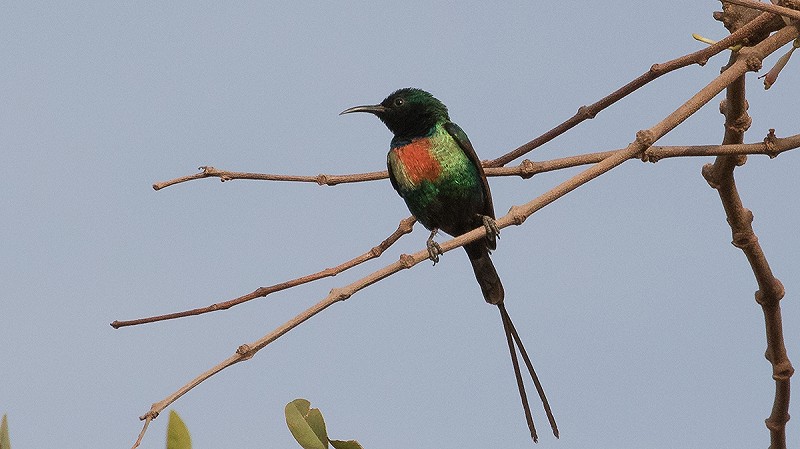 Male Beautiful Sunbird Cinnyris pulchellus, Toubakouta, Senegal, 1 March 2020 (Johan van 't Bosch)
Male Beautiful Sunbird Cinnyris pulchellus, Toubakouta, Senegal, 1 March 2020 (Johan van 't Bosch)
Hotel du Djoudj, Djoudj National Park (23-24 Febr): located next to a large lagoon holding c. 13.000 White-faced Whistling-Ducks and few Lesser Flamingoes. Shallow pools with scrub adjacent to the hotel held dozens of Greater Painted-Snipes, while we flushed a Great Snipe once. Also found at the hotel were Black-headed Weaver, Long-tailed Glossy-Starling, Western Olivaceous Warbler, African Grey Woodpecker, Grey-backed Camaroptera and Senegal Coucal. Long-tailed Nightjar was heard at night. Non-feathered highlights were Patas Monkey, Senegambian Wall Gecko Tarentola senegambiae, Vagrant Emperor, Convolvulus Hawkmoth Agrius convolvuli and Eyprepocnemis nr. plorans (grasshopper).
Ranch de Bango, Saint-Louis (25 Febr): located in an outskirt of town, the hotel grounds held several large acacacias. Birds seen include Senegal Batis, Western Red-billed Hornbill, Northern Crombec, Sudan Golden & Northern Grey-headed Sparrow, Subalpine Warbler, Western Olivaceous Warbler, Scarlet-chested & Beautiful Sunbird, Red-billed Firefinch, Little Swift & Red-rumped Swallow. Pearl-spotted Owlet, Long-tailed Nightjar and Yellow-crowned Gonolek were only heard.
Le Relais de Kaolack, Kaolack (26-27 Febr): this hotel borders the wide Saloum river and has a nice shaded observation deck with leisure seats. Here, birds like Slender-billed Gull, Pink-backed Pelican and Western Reef Heron were seen at close quarters. Its garden consists mainly of small trees and held little more than Speckled Pigeon and Red-cheeked Cordon-bleu. Especially nice here were Four-toed Hedgehog, Sierra Leone Wall Gecko and Convolvulus Hawkmoth.
Keur Saloum, Toubakouta (28-29 Febr): overlooking the mangroves, this lovely lodge consists of African-style round huts (with A/C, mosquito nets and great shower) amidst dry scrub where we saw birds like Bearded Barbet, Senegal Parrot, Yellow-crowned Gonolek, African Grey & Western Red-billed Hornbill, Copper Sunbird and Wire-tailed Swallow; Brown-throated Wattle-eye was only heard. Gambian Epauletted Fruit Bats Epomophorus gambianus were roosting on the thatched dining room roof during the day. Our boat into the Saloum mangroves departed from the hotel and here we saw White-crested Tiger Heron, Blue-cheeked & Swallow-tailed Bee-eaters, trip-exclusive Goliath Herons and Palm-nut Vulture, among others.
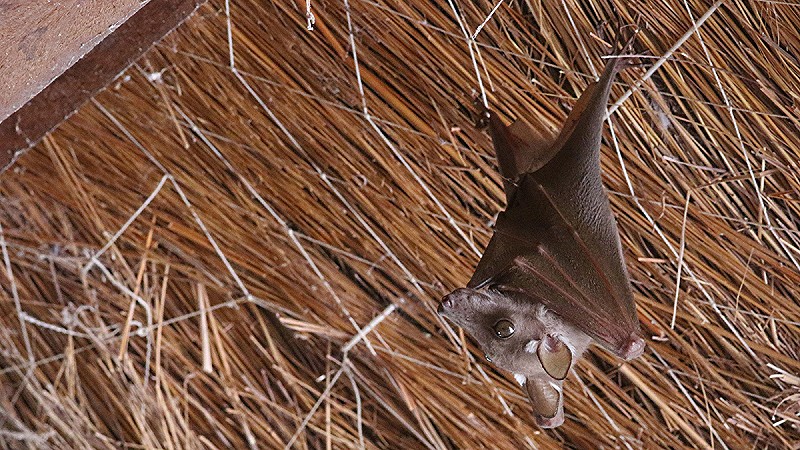 Gambian Epauletted Fruit Bat Epomophorus gambianus, Keur Saloum, Toubakouta, Senegal, 28 February 2020 (Vincent Hart)
Gambian Epauletted Fruit Bat Epomophorus gambianus, Keur Saloum, Toubakouta, Senegal, 28 February 2020 (Vincent Hart)
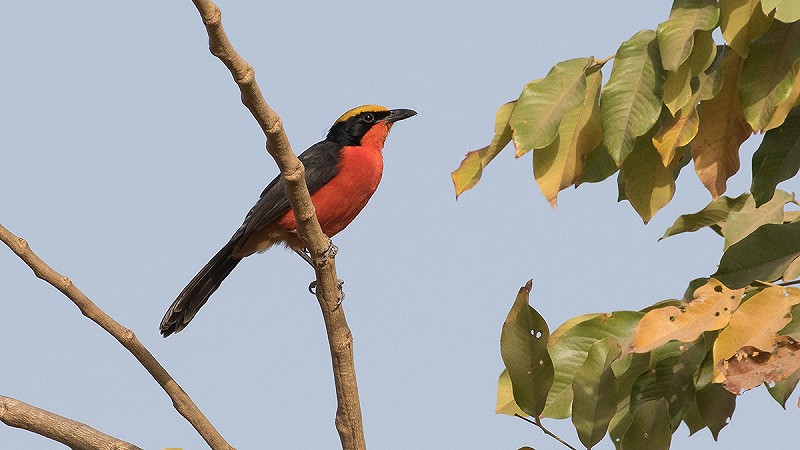 Yellow-crowned Gonolek Laniarius barbarus, Toubakouta, Senegal, 29 February 2020 (Johan van 't Bosch)
Yellow-crowned Gonolek Laniarius barbarus, Toubakouta, Senegal, 29 February 2020 (Johan van 't Bosch)
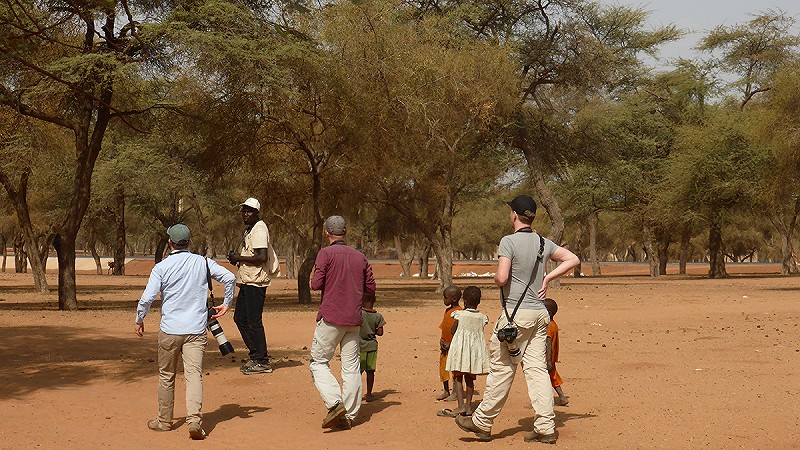 Johan, Abdou, Bertus and Vincent at Little Grey Woodpecker site Dendropicos elachus, Richard Toll, Senegal, 22 February 2020 (Remco Hofland)
Johan, Abdou, Bertus and Vincent at Little Grey Woodpecker site Dendropicos elachus, Richard Toll, Senegal, 22 February 2020 (Remco Hofland)
DAY-BY-DAY & best sightings
Fri Febr 21 - Amsterdam-Lisbon
Departed Amsterdam airport with TAP at 6 pm, arriving Lisbon 8 pm local time; Johan, Vincent & Remco departing Lisbon at 9 pm; Bertus at 10.30 pm.
Sat Febr 22 - Lisbon-Dakar-Richard Toll
Arrival at Dakar airport around 1 am and 2.30 am respectively. Our driver Modou drove us to Richard Toll in about 5 hours, including a half-hour rest along the way. First birds seen from the car were several male Montagu’s Harriers, incl a melanistic one, Piapiac and Black Stork. Checked in and had breakfast at Gite d’Etape, Richard Toll. Started birding at 10 am in a Sahelian landscape just east of Richard Toll, with large acacias and Greater Blue-eared & Chestnut-bellied Starling, Sudan Golden Sparrow, Glossy-backed Drongo, Vieillot’s Weaver, Striped Kingfisher (heard-only), Senegal Eremomela, Blue-naped Mousebird, Little Weaver and Gambian Sun Squirrel. Palearctic migrants found here incl Yellow-headed Wagtail Motacilla flava flavissima, Common Redstart, Northern Wheatear, Tree Pipit, Western Bonelli’s, Subalpine and Western Orphean Warbler. Our first major target materialised in the form of a female Little Grey Woodpecker at 10.30 am, followed by a vocal pair of (target #2) Sennar Penduline-Tit and Brubru.
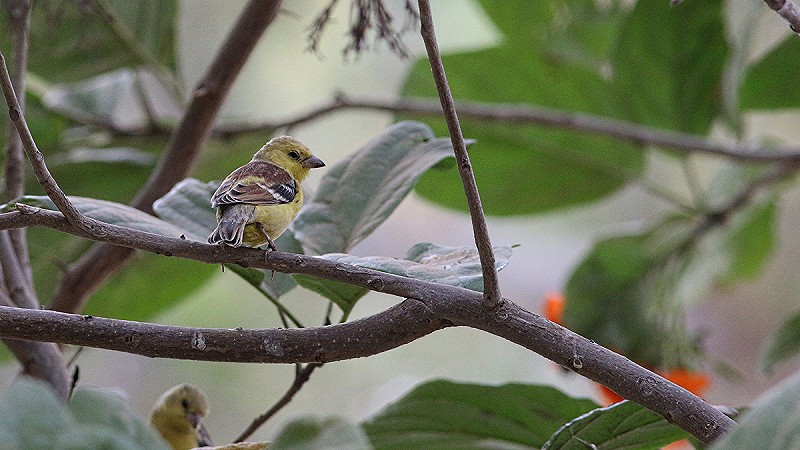 Male Sudan Golden Sparrow Passer luteus, Richard Toll, Senegal, 22 February 2020 (Vincent Hart)
Male Sudan Golden Sparrow Passer luteus, Richard Toll, Senegal, 22 February 2020 (Vincent Hart)
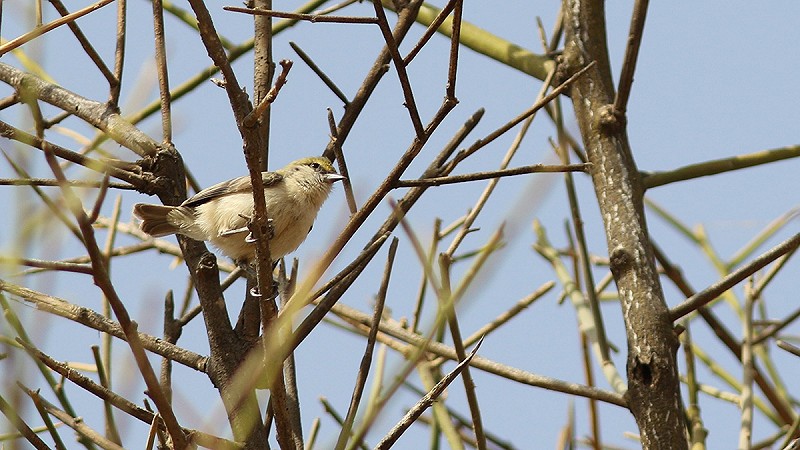 Sennar Penduline Tit Anthoscopus punctifrons, Richard Toll, Senegal, 22 February 2020 (Vincent Hart)
Sennar Penduline Tit Anthoscopus punctifrons, Richard Toll, Senegal, 22 February 2020 (Vincent Hart)
A more sparsely vegetated area nearby delivered our first Woodchat and Desert Grey Shrike Lanius excubitor leucopygus, and the rarely-seen Fulvous Babbler ssp buchanani. Checking hedges yielded the first of several Black Scrub Robin, Spotted Thick-knee, eight Long-tailed Nightjars roosting under the same hedge and trip-exclusive Black-crowned Sparrowlark. Had lunch and a break between 1.30 and 4 pm at Gite d’Etape in Richard Toll, after which we drove to a barren area just outside Richard Toll. Again, it didn’t take long before we saw target #3: c 8 Cricket Warblers.
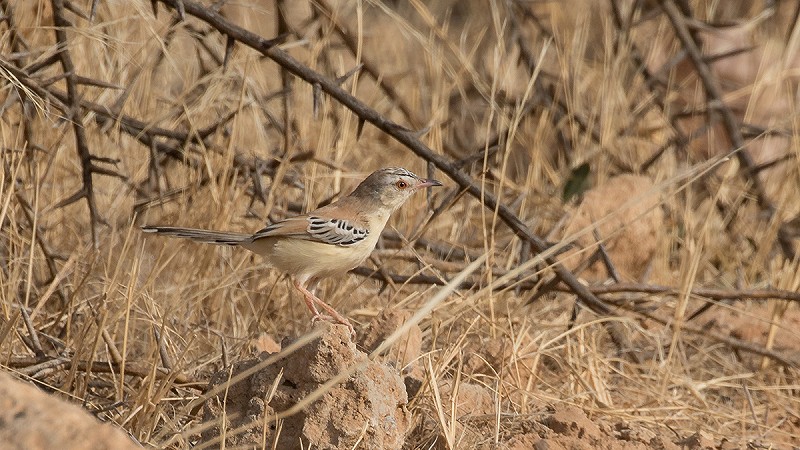 Cricket Warbler Spiloptila clamans, Richard Toll, Senegal, 22 February 2020 (Johan van 't Bosch)
Cricket Warbler Spiloptila clamans, Richard Toll, Senegal, 22 February 2020 (Johan van 't Bosch)
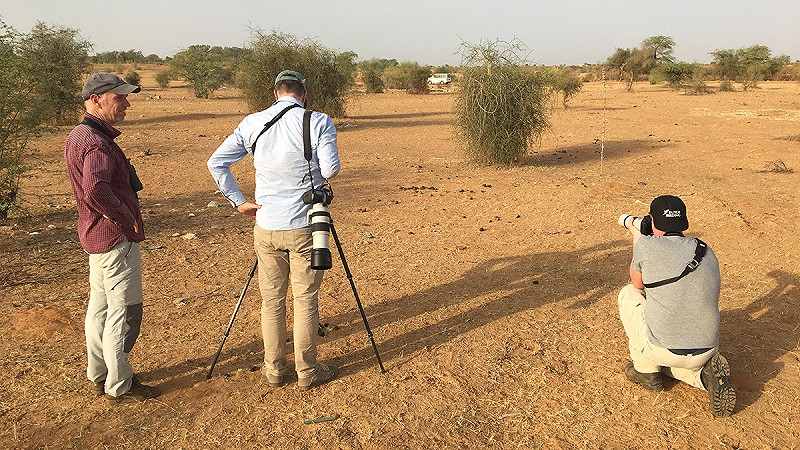 Bertus, Johan and Vincent drooling over Golden Nightjar at Cricket Warbler site Caprimulgus eximius, Richard Toll, Senegal, 22 February 2020 (Remco Hofland)
Bertus, Johan and Vincent drooling over Golden Nightjar at Cricket Warbler site Caprimulgus eximius, Richard Toll, Senegal, 22 February 2020 (Remco Hofland)
More Black Scrub Robins, Yellow-bellied Eremomela, Rufous-tailed Scrub Robins (of the migrant galactotes race) entertained us here. A few kms onwards Vincent realised he’d lost his shades at the Cricket Warbler site, and we returned to look for it. Despite many bits of plastic scattered over the area, Vincent managed to find his shades within 10 mins – and flushed two Golden Nightjars (target #4) in the process. They both settled in plain sight and we obtained fantastic scope views from less than 5m distance. The evening was spent at a nearby old airport, where several feeding Chestnut-bellied Sandgrouse and our first Temminck’s Coursers of the trip were the highlights.
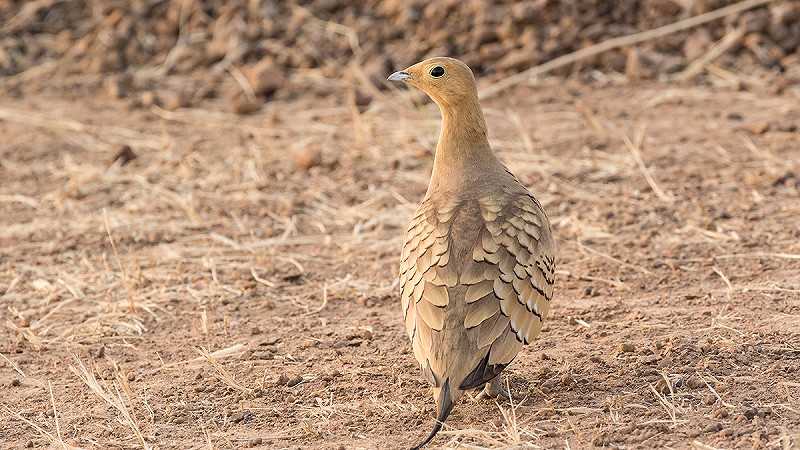 Male Chestnut-bellied Sandgrouse Pterocles e. exustus, Richard Toll, Senegal, 22 February 2020 (Johan van 't Bosch)
Male Chestnut-bellied Sandgrouse Pterocles e. exustus, Richard Toll, Senegal, 22 February 2020 (Johan van 't Bosch)
Having seen our four Northern Senegal targets this first day we realised our only wishbird left in the Podor area was Horus Swift, so we decided to skip Podor entirely in favour of being able to spend an extra day on one of our three remaining (usually) difficult targets: Arabian Bustard, Quail-plover and White-crested Tiger Heron … so it was off to the Djoudj tomorrow! Stayed at Gite d’Etape in Richard Toll.
Sun Febr 23 - Richard Toll to Djoudj
Highlights during the early morning drive from Richard Toll to our first birding stop near Ross Béthio were several hunting males Montagu’s Harrier, lifer White-rumped Seedeater and trip-exclusive Tawny Pipit. Lowlight was a roadkill Striped Hyena. At Ross Béthio we searched in vain for Greater Swamp Warbler; summer-plumaged Black-headed Weavers here were nice though, as was our first African Swamphen and a large flock of Senegal Thick-knees. The fields north of Ross Béthio delivered the goods: 1,000’s of murmurating Red-billed Queleas were spectacular, feeding Chestnut-backed Sparrowlarks and Crested Larks ssp senegallensis were nice, but the real prizes were small flocks of Orange-breasted Waxbills and Quailfinches.
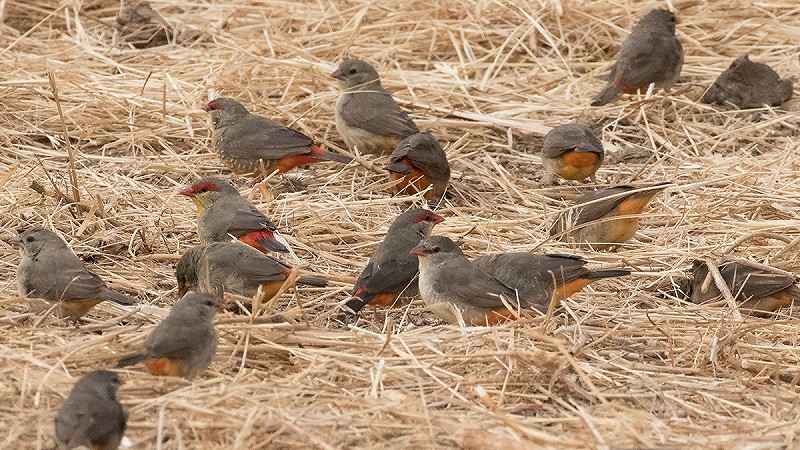 Orange-breasted Waxbill Amandava subflava, Ross Béthio, Senegal, 23 February 2020 (Johan van 't Bosch)
Orange-breasted Waxbill Amandava subflava, Ross Béthio, Senegal, 23 February 2020 (Johan van 't Bosch)
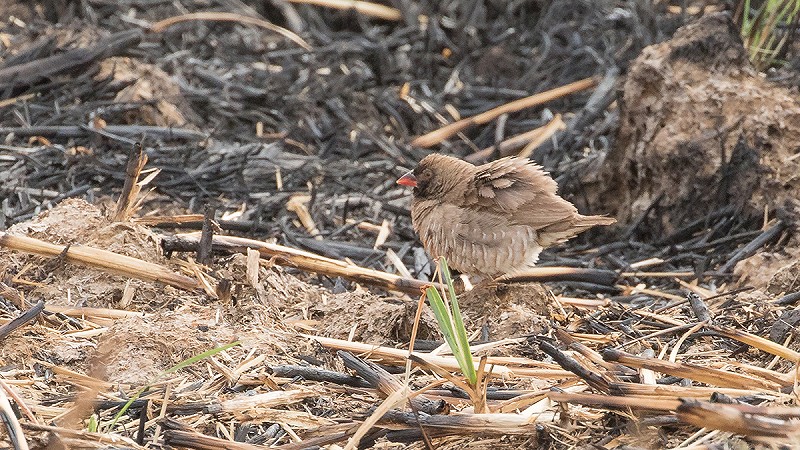 Quailfinch Ortygospiza atricollis, Ross Béthio, Senegal, 23 February 2020 (Johan van 't Bosch)
Quailfinch Ortygospiza atricollis, Ross Béthio, Senegal, 23 February 2020 (Johan van 't Bosch)
Other interesting birds here were Yellow-crowned and Northern Red Bishop – both in non-breeding plumage though – and a spectacular Truxalis grasshopper.
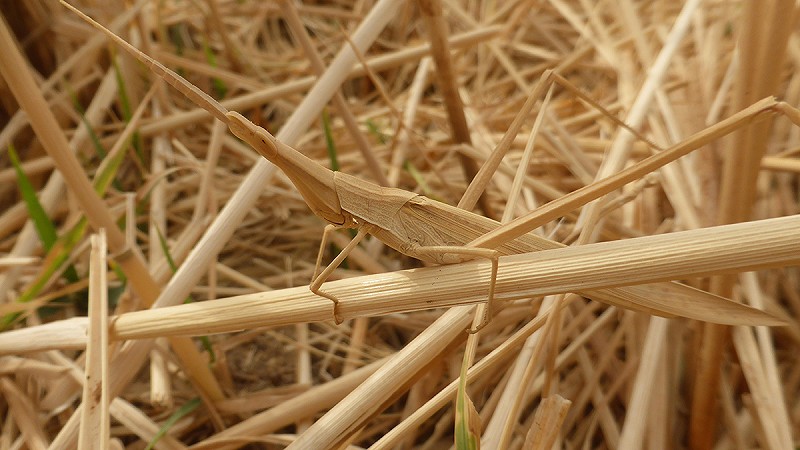 Grasshopper sp. Truxalis sp., Ross Béthio, Senegal, 23 February 2020 (Johan van 't Bosch)
Grasshopper sp. Truxalis sp., Ross Béthio, Senegal, 23 February 2020 (Johan van 't Bosch)
Not far from Ross Béthio we encountered our first River Prinia (target #5), shortly thereafter followed by Greater Swamp Warbler, a lifer for all, and other nice birds in the form of Kittlittz’ Plover, Winding Cisticola and Marsh Sandpiper. Our first African Golden Wolf was seen along the entrance road to Djoudj National Park, while the lagoon next to the Hotel du Djoudj held a few Fulvous and an estimated 13,000 White-faced Whistling-Ducks.
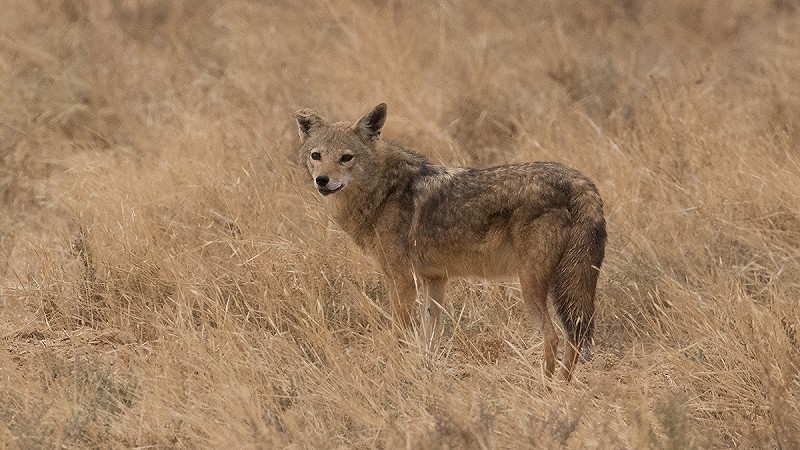 African Golden Wolf Canis anthus anthus, Djoudj, Senegal, 23 February 2020 (Johan van 't Bosch)
African Golden Wolf Canis anthus anthus, Djoudj, Senegal, 23 February 2020 (Johan van 't Bosch)
Checked into Hotel du Djoudj, after having checked the rubbish-ridden scrubby ponds behind the hotel: eight Greater Painted Snipes feeding and a flushed Great Snipe. After lunch and a rest we departed into the National Park at 3.30 pm. Despite the northern wind having picked up we enjoyed many good sightings including several African Golden Wolf, Common Warthogs, Collared Pratincole, males Montagu’s and Pallid Harrier. When we arrived at the southern edge of the large lake at 5 pm it turned out that the cold northern wind had one big advantage: it pushed the incredible numbers of ducks close inshore, so that we could identify the closest 50,000 …. we recognised at least 20,000 male Garganey, 10,000 (also mostly male) Northern Pintail, 1,000’s of Northern Shoveler, 25,000 Greater Flamingo, c 8,000 White-faced Whistling-Ducks and found four Marbled Duck. [No less than 400,000 White-faced Whistling-Ducks and 150.000 Garganey are said to winter in the Djoudj, according to the local guide!] Low over the lake we witnessed incredible numbers of feeding swallows and martins, many too far for certain ID, but I estimated two million Sand Martins were among them. Two Western Barn Owls ssp poensis roosting in two lakeshore observation huts were also very nice. Next highlight was the Arabian Bustard ssp stieberi (target #6) that Abdou found strutting distantly at 7 pm, while 19 Black Crowned Cranes and two Black Storks were feeding a bit closer. Stayed at Hotel du Djoudj.
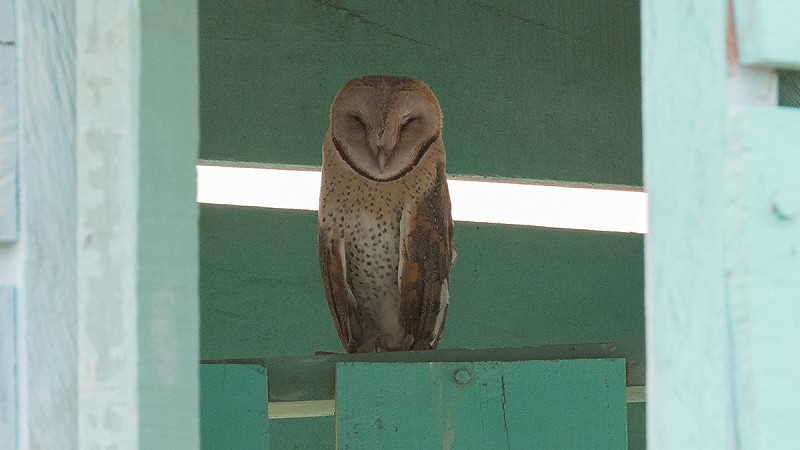 Western Barn Owl Tyto alba poensis, Djoudj, Senegal, 23 February 2020 (Johan van 't Bosch)
Western Barn Owl Tyto alba poensis, Djoudj, Senegal, 23 February 2020 (Johan van 't Bosch)
Mon Febr 24 - Djoudj
In the morning we found the Arabian Bustard at the same site. After a 20-min strut it flew across the track in front of us and landed at a sand dyke separating the flat area from the reedbeds, where it started feeding on (pollen or insects in) yellow flowers. For about an hour we watched this bird, and saw another fly past. In the same area we saw Black Crowned Cranes and many Sudan Golden Sparrows, while Knob-billed Ducks and a Spur-winged Goose flew overhead. We then headed towards the departure point for boats leaving to the pelican colony. Along the way we played the tape of Aquatic Warbler at sedge beds we encountered – but only saw Sedge Warblers, River Prinias and our first African Stonechat ssp moptanus. Swamps bordering the river near the depature point held Yellow-billed Stork, many parasolling Black Heron, African Spoonbill, African Sacred Ibis and African Darter.
Black Herons Egretta ardesiaca, Djoudj, Senegal 24 February 2020 (Remco Hofland)Where Common Warthogs encountered earlier were weary, here they walked in between the tourists. Abdou arranged a private boat and we headed off towards the Great White Pelican colony. The river was birdy, with Blue-cheeked Bee-eater, Caspian, Gull-billed, White-winged and Whiskered Tern, Red-chested Swallow, Eurasian Wryneck, many Squacco Herons and several pairs of African Pygmy Goose.
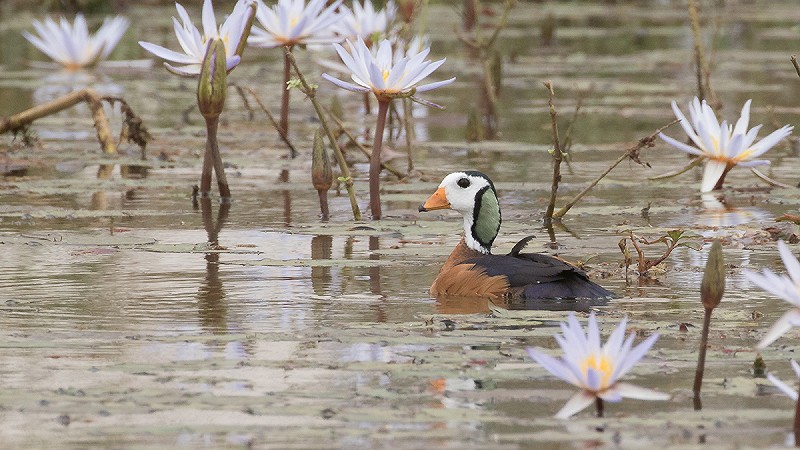 Male African Pygmy Goose Nettapus auritus, Djoudj, Senegal, 24 February 2020 (Johan van 't Bosch
Male African Pygmy Goose Nettapus auritus, Djoudj, Senegal, 24 February 2020 (Johan van 't Bosch
An aberrant African Jacana had a fully black neck and face, its frontal shield still bluish. Truly amazing were the c 7,000 (primarily adult) Great White Pelicans we witnessed feeding only meters from our boat, scooping up large fish – no match for the White-breasted and Reed Cormorants and egrets also present. The colony held an estimated 5,000 smelly and loud juvenile Great White Pelicans.
Great White Pelicans Pelecanus onocrotalus, Djoudj, Senegal, 24 February 2020 (Remco Hofland)After the boat trip Abdou showed us a bush of small trees full of wintering (Iberian) Chiffchaffs, many of which showed characteristics of Common rather than Iberian. An estimated 700 Black-crowned Night Herons roosted in the lakeside trees here. After lunch at Hotel du Djoudj we spent late afternoon watching Greater Painted Snipes and other waders.
Female Greater Painted Snipe Rostratula benghalensis, Hotel du Djoudj, Senegal, 24 February 2020 (Remco Hofland)The orange haze the Saharan northerlies created prevented us from locating the Montagu’s & Western Marsh Harrier roost the local guide told us about would be situated in the rice fields just outside the park. Dinner and stayed at Hotel du Djoudj.
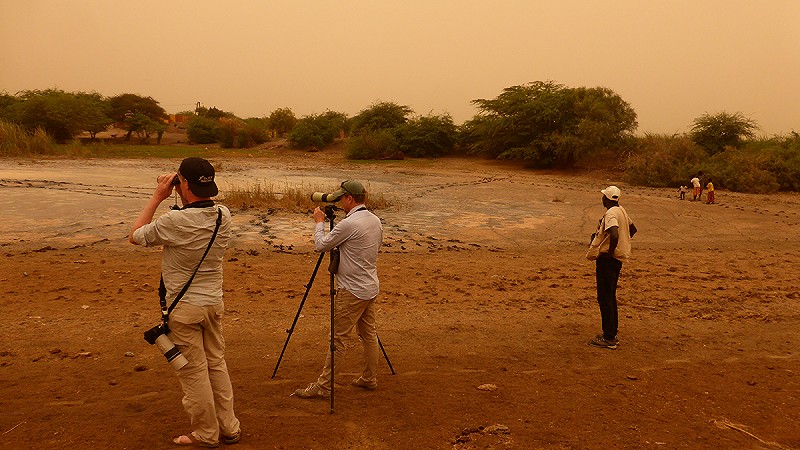 Vincent and Johan in the orange haze, Djoudj, Senegal, 24 February 2020 (Remco Hofland)
Vincent and Johan in the orange haze, Djoudj, Senegal, 24 February 2020 (Remco Hofland)
Tue Febr 25 - Djoudj to Saint-Louis
When departing the Djoudj we first witnessed a pair and a young Black Crowned Crane feeding, followed by a flock of 33 Black Crowned Cranes and yet another African Golden Wolf. We headed straight to Les Tres Marigots, a scrubby area east of Saint-Louis with small ponds. This site is Abdou’s stronghold for our next target (#7), Savile’s Bustard. Abdou was shocked to learn that about half of the site was recently cleared, probably for agriculture. The other half, north of the track, still consisted of thick scrubby bush and after a tense initial 15 mins we saw our first Savile’s Bustard, a female close the track. This was soon followed by another three sightings that morning, with four more in the afternoon (I guess we saw at least six different individuals!).
Male Savile’s Bustard Lophotis savilei, Les Tres Marigots, Saint-Louis, Senegal, 25 February 2020 (Remco Hofland)Other interesting birds here including Double-spurred Francolin, a leucistic Anteater Chat, Plain-backed Pipit, a pair of Senegal Batis and a flock of 18 Collared Pratincole. Between 1 and 3.30 pm we checked into, had lunch and birded at Ranch de Bango in Saint-Louis, before returning to Les Tres Marigots. Birds seen on the hotel grounds incl Senegal Batis, Northern Crombec, Sudan Golden Sparrow, Subalpine Warbler, Western Olivaceous Warbler and Scarlet-chested Sunbird.
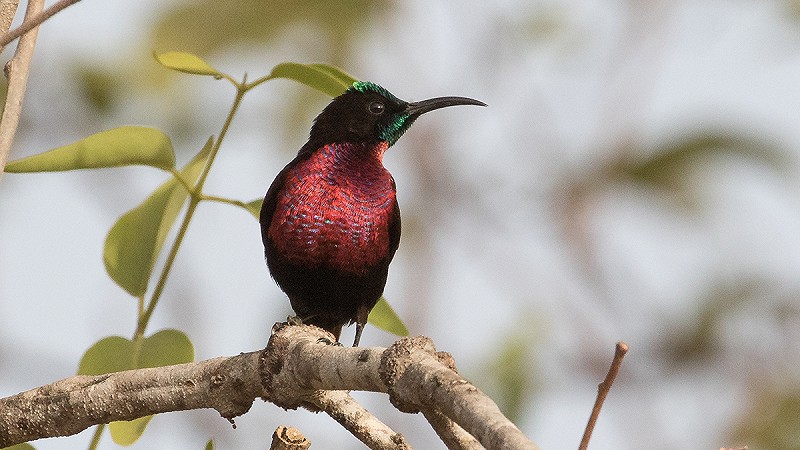 Scarlet-chested Sunbird Chalcomitra senegalensis, near Toubakouta, Senegal, 1 March 2020 (Johan van 't Bosch)
Scarlet-chested Sunbird Chalcomitra senegalensis, near Toubakouta, Senegal, 1 March 2020 (Johan van 't Bosch)
When passing the bustard scrub we saw another four Savile’s Bustards, but soon we headed towards the marshier bits further northeast at Les Tres Marigots in search of Allen’s Gallinule and Lesser Moorhen. Abdou informed us there was considerable doubt over the identity of the ‘Lesser Moorhens’ occurring here; our preliminary conclusion after seeing several individuals is that here, wintering Common Moorhen ssp chloropus occur side-by-side with sub-Saharan, smaller ssp meridionalis. We saw a few birds unlike chloropus that may have been second-summer meridionalis. The marsh held many Black Crakes, a few African Swamphens and Allen’s Gallinules, a Greater Painted Snipe and a very secretive (probably first-winter) Baillon’s Crake that showed itself on and off for only seconds each time. Dinner and stayed at Ranch de Bango in Saint-Louis.
Wed Febr 26 - Saint-Louis to Kaolack
On our way to Kaolack we drove past the river in Saint-Louis, where a few quick stops revealed Caspian & West African Crested Terns, Grey-headed and a single Audouin’s Gull, Pink-backed Pelican and several Grey Herons – though not the hoped-for ssp monicae. At tidal areas south of Saint-Louis we encountered many Eurasian Spoonbills and trip-exclusive Sanderling and Ruddy Turnstone. Near the village of Dabaye, south of Saint-Louis, we found a number of large vultures in a roadside tree: Lappet-faced, Rüppell’s, Eurasian Griffon and African White-backed Vultures. Along this road Anteater Chat and Chestnut-bellied Starling were frequent, as well as the occasional Hooded Vulture.
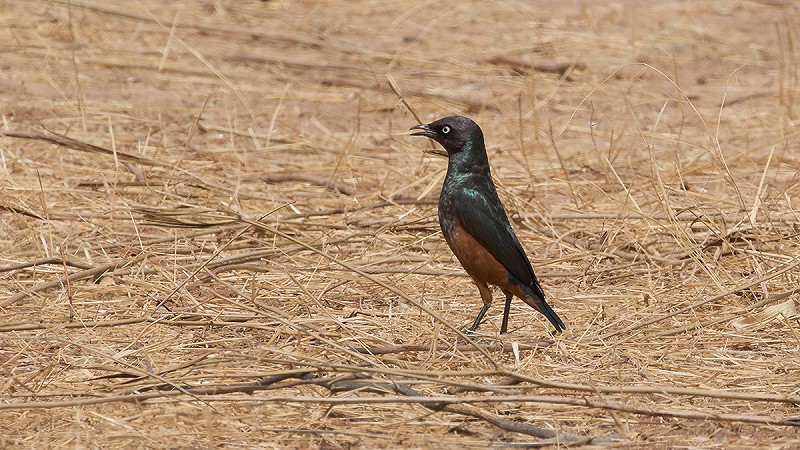 Chestnut-bellied Starling Lamprotornis pulchur, near Touba, Senegal, 26 February 2020 (Johan van 't Bosch)
Chestnut-bellied Starling Lamprotornis pulchur, near Touba, Senegal, 26 February 2020 (Johan van 't Bosch)
At a roadside waterhole near Darou Mousty we found Sahel Paradise-Whydah (target #8), along with an array of other species incl Mottled Spinetail, Black-crowned Tchagra, Blue-naped Mousebird, Eurasian Wryneck, White-rumped Seedeater, Sudan Golden Sparrow and Chestnut-backed Sparrowlark. Next stop was south of Touba, in a dry sandy area with a specific low bush, home of the enigmatic Quail-plover. The five of us did not encounter any on our first half-hour-walk through the area, but instead bumped into a male Savile’s Bustard, African (Rufous-tailed) Scrub Robin ssp minor, Desert Cisticola and Singing Bushlark. However, after a well-deserved water break (it was c 40º C) we flushed a Quail-plover (target #9) that landed 30m further. We could study the bird very well in the scope, as it hid in the shade of a bush – it even started its chameleon-like hesitating walk after c 20 mins.
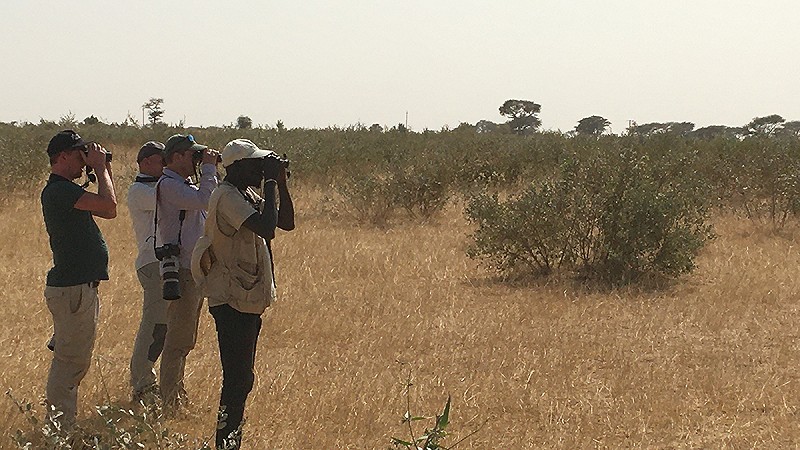 Vincent, Bertus, Johan and Abdou watching Quail-plover Ortyxelos meiffrenii, Touba, Senegal, 26 February 2020 (Remco Hofland)
Vincent, Bertus, Johan and Abdou watching Quail-plover Ortyxelos meiffrenii, Touba, Senegal, 26 February 2020 (Remco Hofland)
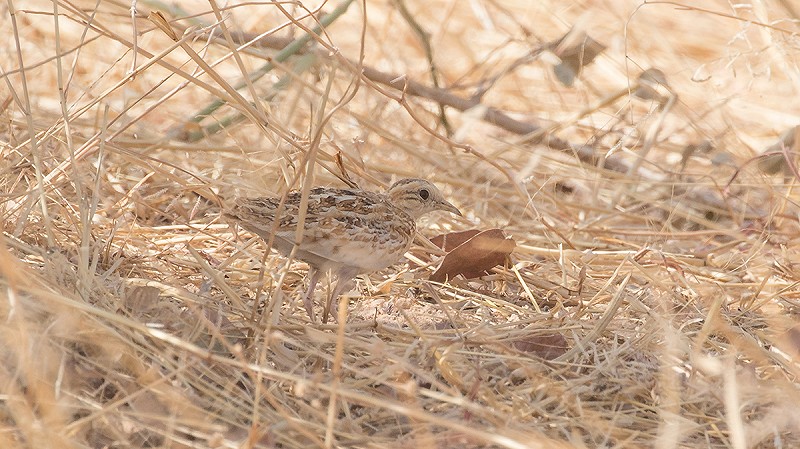 Quail-plover Ortyxelos meiffrenii, south of Touba, Senegal, 26 February 2020 (Johan van 't Bosch)
Quail-plover Ortyxelos meiffrenii, south of Touba, Senegal, 26 February 2020 (Johan van 't Bosch)
African White-backed & Rüppell’s Vultures flew overhead. Our last stop was east of Gossas, where highlights were Vinaceous Dove, Vieillot’s & Bearded Barbet, three Yellow-crowned Gonoleks, Cut-throat Finch, African (Rufous-tailed) Scrub Robin ssp minor, African Grey Hornbill and Pearl-spotted Owlet. We checked into Le Relais de Kaolack in Kaolack in the dark.
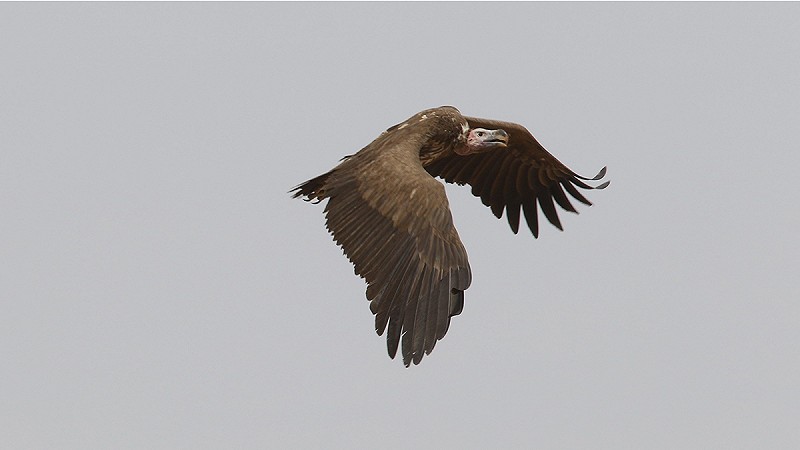 Lappet-faced Vulture Torgos tracheliotos, northeast of Tiamene, Senegal, 1 March 2020 (Vincent Hart)
Lappet-faced Vulture Torgos tracheliotos, northeast of Tiamene, Senegal, 1 March 2020 (Vincent Hart)
Thu Febr 27 - Kaolack incl Kousmar island
We birded the morning in dry scrub and agricultural fields west of Kaolack, between the road and Kousmar island. It didn’t take long before we were watching this trip’s first Scissor-tailed Kites (target #10), most preening in the top of small baobab trees, with some feeding. Other interesting birds here include Lesser Kestrel, White-billed Buffalo-weaver, Verreaux’s Eagle-Owl, Piapiac, Temminck’s Courser, Black-headed Lapwing, a flock of c 70 Senegal Thick-knees, Savile’s Bustard, Pygmy Sunbird and the omnipresent Abyssinian Roller.
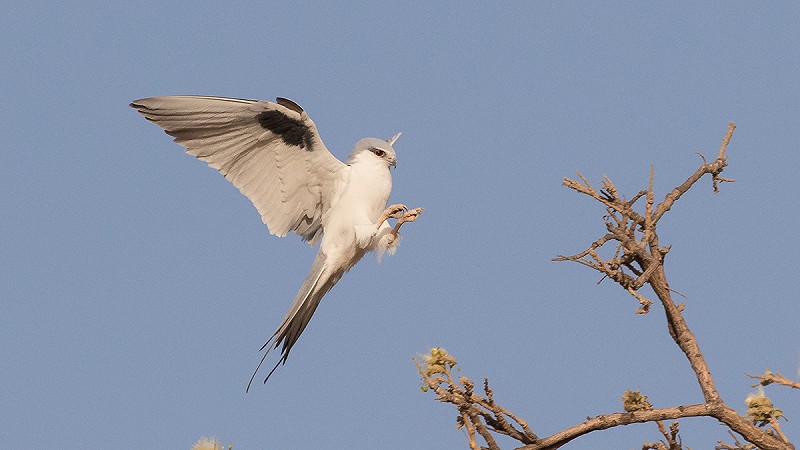 Scissor-tailed Kite Elanoides forficatus, Kaolack, Senegal, 27 February 2020 (Johan van 't Bosch)
Scissor-tailed Kite Elanoides forficatus, Kaolack, Senegal, 27 February 2020 (Johan van 't Bosch)
Between 2 and 4 pm we had lunch and a rest at Le Relais de Kaolack. In the afternoon we headed back to Kousmar island, where it took us two 100-m boatrides to get all five of us across Saloum river in a dug-out canoe to the mudflat south of the island. From the drop-off point it was a 2-km walk over the, mostly dry, mudflats onto the island, that was dominated by tall dry grass and baobab trees. At 5 pm we installed ourselves in the shade and sat on the ground while waiting for kites and kestrels to appear. Calling Savile’s Bustard and Double-spurred Francolin (both HO), a singing Black Scrub Robin and a Common Whitethroat were about the only birds we noted on the island, before at 5.30 pm the first Scissor-tailed Kites and Lesser Kestrel started cirkelling high overhead. We witnessed more and more kites and kestrels coming down to roost in three baobabs near us, some kites calling when they flew in, until 7 pm; in all, we saw c 530 Scissor-tailed Kites and c 220 Lesser Kestrels. While walking back over the mudflat at dusk we saw quite a few single Kestrels, probably Common, flying towards the island to roost, as well as some African Grey and Western Red-billed Hornbills; three Long-tailed Nightjars were feeding above the river. Stayed at Le Relais de Kaolack in Kaolack.
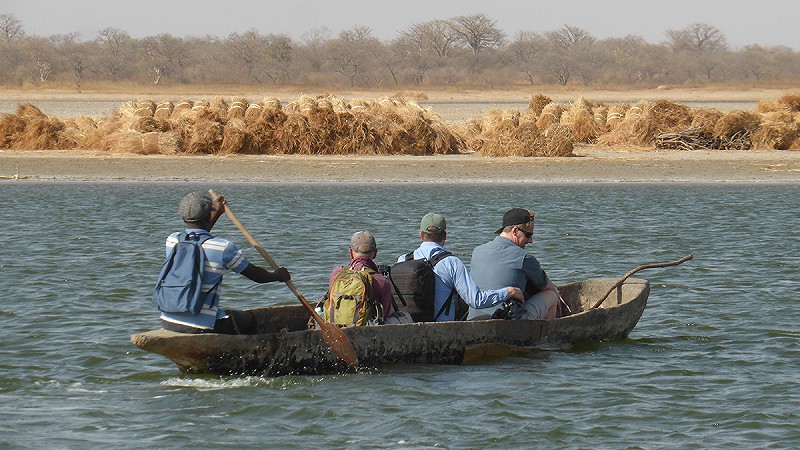 Crossing Saloum river to Kousmar island in a dug-out canoe, west of Kaolack, Senegal, 27 February 2020 (Remco Hofland)
Crossing Saloum river to Kousmar island in a dug-out canoe, west of Kaolack, Senegal, 27 February 2020 (Remco Hofland)
Fri Febr 28 - Kaolack to Toubakouta
Upon departure from the hotel I bumped into one of my trip’s highlights: a Four-toed Hedgehog wobbling through the garden! We returned to the agricultural fields south of Kousmar island so Johan and Vincent could have another shot at photographing Scissor-tailed Kites preening in the early morning sun. At all sites, including the Kousmar island roost, we estimated 4/5th of all birds were immatures and only 1/5th adult. Some other interesting observations were another male Savile’s Bustard, a few Bruce’s Green Pigeons flying overhead, Piapiacs following cattle and Three-striped Ground Squirrel Lariscus insignis. In an hour we drove to Sandicoly, close to Toubakouta, where we visited a cashew grove bordering the mangroves, a site Abdou knew to be good for several birds new to our triplist, including lifer Yellow-throated Leaflove. Indeed it turned out to be the birdiest place of the trip, with between 10 am and noon highlights including Senegal Parrot, White-crowned Robin-chat, Fine-spotted Woodpecker, Blue-breasted Kingfisher, African Wattled Lapwing, Blue-spotted and the more common Black-billed Wood Dove, African Harrier-Hawk, African Paradise-Flycatcher, African Grey Woodpecker mobbing, in fact pecking, a Pearl-spotted Owlet, Purple & Blue-bellied Roller, Yellow-billed Shrike, Yellow-billed Oxpecker, Greater Honeyguide, Green Woodhoopoe, Brown & Blackcap Babbler and Lavender Waxbill.
Female African Grey Woodpecker mobbing Pearl-spotted Owlet Dendropicos goertae, Toubakouta, Senegal, 28 February 2020 (Remco Hofland)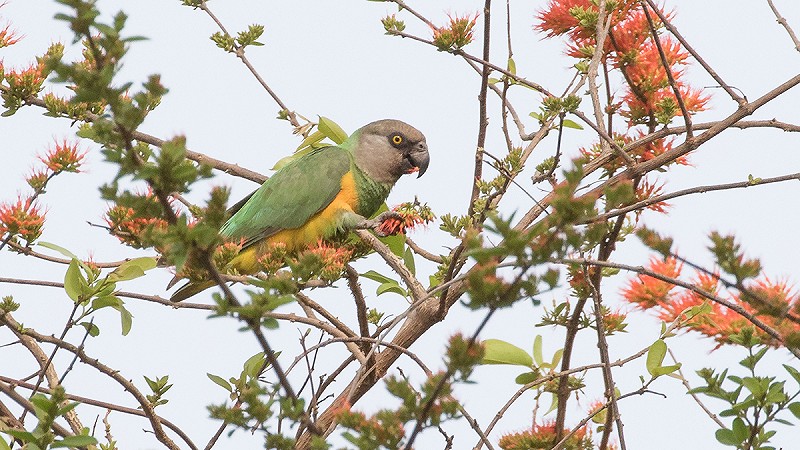 Senegal Parrot Poicephalus senegalus, Toubakouta, Senegal, 1 March 2020 (Johan van 't Bosch)
Senegal Parrot Poicephalus senegalus, Toubakouta, Senegal, 1 March 2020 (Johan van 't Bosch)
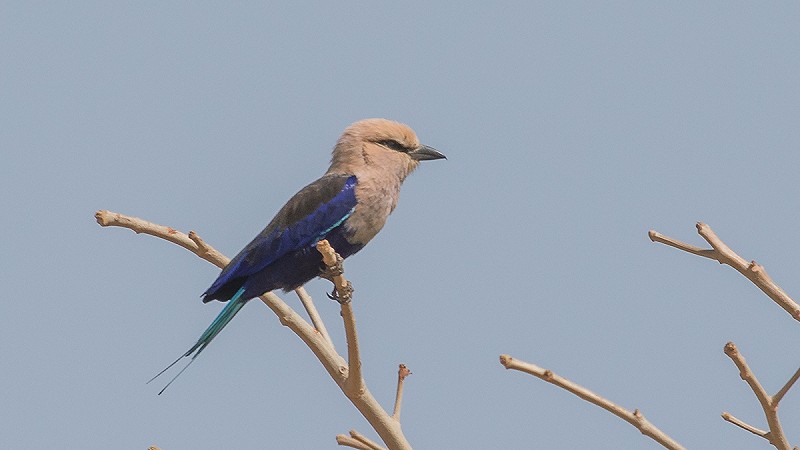 Blue-bellied Roller Coracias cyanogaster, Toubakouta, Senegal, 28 February 2020 (Johan van 't Bosch)
Blue-bellied Roller Coracias cyanogaster, Toubakouta, Senegal, 28 February 2020 (Johan van 't Bosch)
Checked into the Keur Saloum at Toubakouta where we had lunch and a rest before going out again at 3.30 pm. During our lunch/afternoon rest we saw Wire-tailed Swallow & Copper Sunbird and heard Brown-throated Wattle-eye singing. We departed the boat ramp in front of the Keur Saloum at 3.40 pm and headed into the mangroves, with a favourable switch to low tide. While the mangroves were pretty slow birding, we still saw some nice birds such as Blue-cheeked Bee-eaters, Mangrove (Mouse-brown) Sunbird, a Striated and 5 Goliath Heron, Caspian & Gull-billed Tern and Western Ospreys incl a ringed bird that turned out to be German, ringed 14 years earlier. However, White-crested Tiger Heron was of course our main target (#11), and we were pleasantly surprised we found one after only 1.5 hrs of searching! It stood at the edge of one of the smaller side-creeks, in a gap in the foliage and, despite us floating past a few times and, while parked less than 7m away, us shifting seats in the boat to diversify our photo angles, stayed put! We left the bird alone after c 40 mins and saw a few more goodies, such as a few Black Kites in a Yellow-billed Kite roost numbering at least 300 birds and a trip-exclusive Palm-nut Vulture. Excellent dinner and stayed at Keur Saloum in Toubakouta.
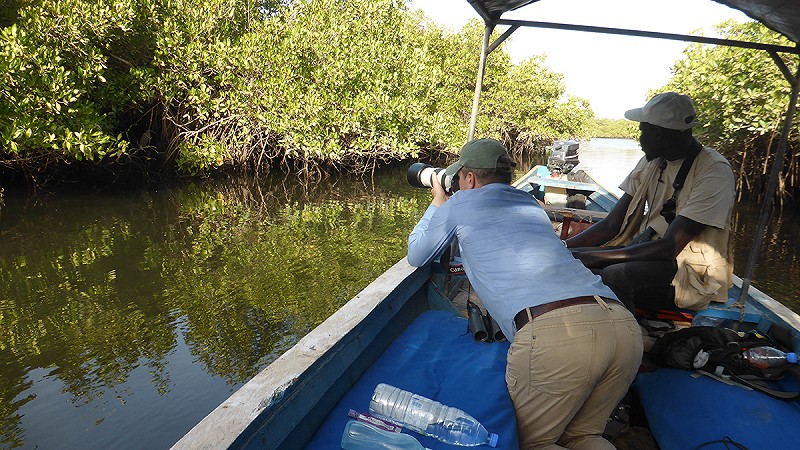 Johan photographing White-crested Tiger Heron Tigriornis leucolopha (visible in the gap in the mangoves), with Abdou, Saloum Delta near Toubakouta, Senegal, 28 February 2020 (Remco Hofland)
Johan photographing White-crested Tiger Heron Tigriornis leucolopha (visible in the gap in the mangoves), with Abdou, Saloum Delta near Toubakouta, Senegal, 28 February 2020 (Remco Hofland)
Sat Febr 29 - Toubakouta
Yellow-crowned Gonolek & Common Bulbuls drinking from the breakfast fruitjuices kept us entertained over breakfast at Keur Saloum. Abdou took us to an area of gardens and groves south of Toubacouta where it was delicious birding: Black-rumped & Lavender Waxbill, Black-winged Bishop (untickable views unfortunately), Yellow-billed Shrike, Shikra, Hooded Vulture, Red-eyed Dove, Village Indigobird, African Paradise-Flycatcher, Bronze-tailed Starling & Double-spurred Francolin were some of the goodies seen here.
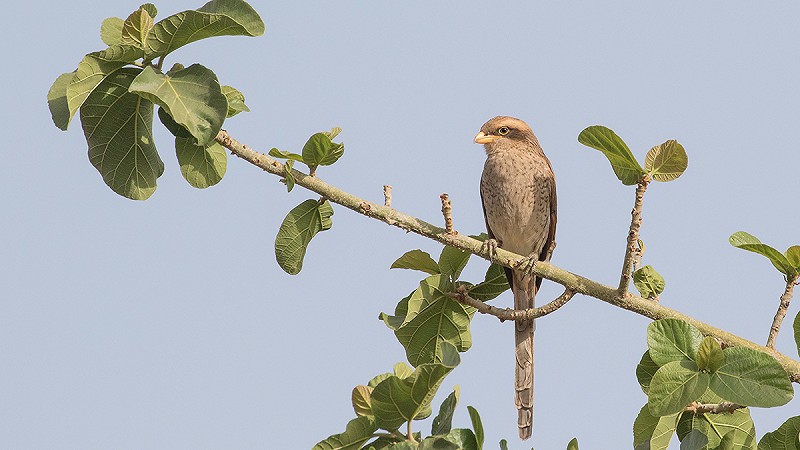 Yellow-billed Shrike Corvinella corvina, near Toubakouta, Senegal, 29 February 2020 (Johan van 't Bosch)
Yellow-billed Shrike Corvinella corvina, near Toubakouta, Senegal, 29 February 2020 (Johan van 't Bosch)
Abdou stopped a few times in dry scrub sites he knew to be good for Yellow Penduline-Tit, my only remaining target besides the Leaflove; despite dipping the Penduline-Tit, we did score with four trip-exclusives: Long-crested Eagle, Beaudouin’s Snake-Eagle, Cardinal Woodpecker & Mosque Swallow, and two trip-firsts: Lizard Buzzard & Grey Kestrel.
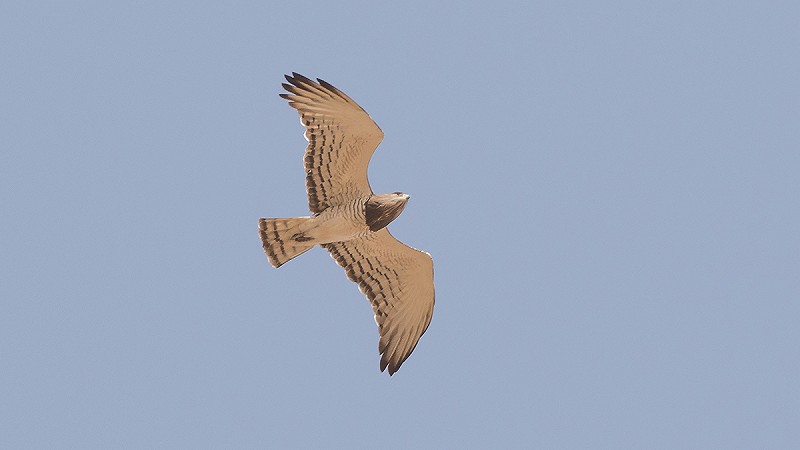 Beaudouin's Snake Eagle Circaetus beaudouini, Toubakouta, Senegal, 29 February 2020 (Johan van 't Bosch)
Beaudouin's Snake Eagle Circaetus beaudouini, Toubakouta, Senegal, 29 February 2020 (Johan van 't Bosch)
Another Penduline-Tit site, dominated by African Boababs Adansonia digitate, was good for Sahel Bush Sparrow (aka Bush Petronia), Black Scimitarbill, Greater Honeyguide, a totally out-of-place Western Osprey flying over and Fine-spotted Woodpecker. Had lunch and a rest at Keur Saloum between 12.45 and 3.30 pm. At 4 pm we found ourselves back at yesterday morning’s Leaflove site. Aside from great views of Blue-spotted Wood Dove (rare here), we saw similar birds to yesterday: Black-necked Weaver, White-crowned Robin-Chat, African Thrush, Blue-breasted Kingfisher. Abdou’s local knowledge paid off, in that he directed us to a tiny pool under a palm tree he knew attracted bathing birds in late afternoon, and here we had wonderful views of African Pygmy Kingfisher, lifer Yellow-throated Leaflove and a pair of Oriole Warbler. A group of Guinea Baboons Papio papio raided the cashew grove, much to the dislike of its owner. While Johan spent time photographing wasps at a muddy pool, we checked another part of the area for Brown-throated Wattle-eye and surely had great views of a male. A flock of 33 European Bee-eaters overhead concluded our birding at this site. At 6 pm we found ourselves at a site northeast of Toubakouta Abdou knew to be good for drinking Four-banded Sandgrouse but the site unfortunately held a band of hunters. We therefore birded another, nearby site where we spent some time watching a flock of 10 Green Woodhoopoes feeding. This place, scrub bordering a reedbed, was very birdy: the low bushes were used by 1,000’s of bishops and weavers on their way to their roosting site. Interesting birds seen here included Grey Kestrel, Pearl-spotted Owlet, Red-necked Falcons hunting weavers at dusk, 100+ Black-rumped Waxbills, Purple Starling, Greater Honeyguide, Black-headed Heron and Hamerkop flying past, as well as c 20 Four-banded Sandgrouse. Dinner and stayed at Keur Saloum in Toubakouta.
Sun Mar 1 - Toubakouta to Dakar
When at the parking of Keur Saloum a Bearded Barbet didn’t pose well enough for a picture, Abdou took us to the edge of Toubakouta, where a large fig tree indeed attracted 4+ Bearded Barbet. From here we walked to the baobab area for our last attempt at Yellow Penduline-Tit, in quick succession connecting with White-rumped Seedeater, Fine-spotted & African Grey Woodpecker and Black Scimitarbill. Despite dipping the Penduline-Tit, our persistence paid off with Cut-throat Finch, Lesser Honeyguide, Purple Starling and, best-of-all, a curious noisy flock of White-crested Helmetshrikes. A few random stops along a road Abdou said would be good for raptors, duly produced a pair of African Hawk-Eagle in a tree, Northern Puffback, Johan’s first Bateleurs and Shikra.
Bearded Barbets Lybius dubius, (especially great footage after 01:45 min) Toubakouta, Senegal, 1 March 2020 (Remco Hofland)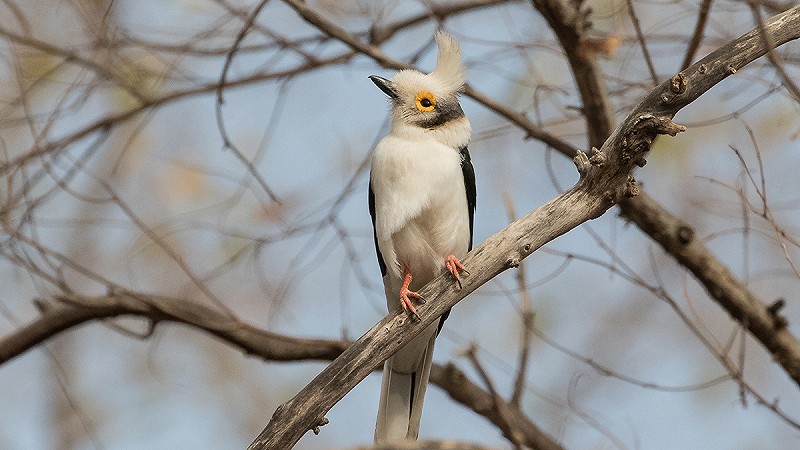 White-crested Helmetshrike Prionops plumatus, Toubakouta, Senegal, 1 March 2020 (Johan van 't Bosch)
White-crested Helmetshrike Prionops plumatus, Toubakouta, Senegal, 1 March 2020 (Johan van 't Bosch)
At a stand of very large trees we also managed to see Green & Patas Monkey and a few of the rare Temminck’s Red Colobus within 10 minutes. Our last birding in the Toubakouta area was near an area of vegetable gardens where we saw a flock of Pin-tailed Whydah, Lanner Falcon and a few Rüppell’s Vultures overhead. After lunch, photographing a Uganda Dwarf Gecko and paying our drinks bill we departed Toubakouta for Dakar. North of Tiamene we noticed some large vultures flying overhead and soon we were watching a dead cow – with c 40 vultures jumping each other for a meal. Eurasian Griffons, Rüppell’s, African White-backed and Lappet-faced Vultures were all present, which made for excellent action and video!
Lappet-faced Torgos tracheliotos, Rüppell’s Gyps rueppellii, African White-backed Vultures Gyps africanus and Eurasian Griffons Gyps fulvus, on dead cow, N5 near Tiamene, Senegal, 1 March 2020 (Remco Hofland)In Thiadiaye town we noticed five Hooded Vultures and a bunch of Pied Crows ripping apart a dead African Giant (aka Gambian) Pouched Rat Cricetomys gambianus. We concluded our Senegalese birding near the town of Saly, at Lagune de Somone, where we took a boat from the beach upriver to a sand bank, parking it next to a large gull roost. We could study, photograph, video and sound-record many of the birds roosting & preening next to us, incl: West African Crested Thalasseus albididorsalis, Caspian, Sandwich & Common Terns, Audouin’s, Grey-headed and many Lesser Black-backed Gulls. A colour-ringed Audouin’s Gull probably originated from Coto Doñana in southern Spain. After dinner at Saly, Modou and Abdou dropped us at Dakar airport around 11 pm.
Mon Mar 2 - Dakar-Lisbon-Amsterdam
Departed Dakar airport at 3.40 am, smoothly made our connection in Lisbon (typically about 1 hr) and arrived at Amsterdam airport at half an hour past noon.
All our sightings, including mammals, reptiles, dragonflies, butterflies, moths, beetles, grasshoppers, wasps and flies are found on Observation.org.
Remco Hofland
Discussie
Bertus de Lange
·
21 April 2020 14:08
Erg mooi geworden Remco! Prachtige herinneringen aan een hele fijne reis.
Redmar Woudstra
·
21 April 2020 14:50
Nice report!
I was wondering if I had missed a taxonomic change, or that I we are dealing with another species: I was not aware Black-headed Weaver is local? As far as I know I saw that species easily in Kenya and Tanzania, and also in Senegal.
Remco Hofland
·
21 April 2020 18:24, gewijzigd 21 April 2020 18:24
Hi Redmar, I think we’re talking about the same species. What I mean is that the species, although it occurs in about 18 different countries, is localised in that it is limited to wet habitats. That may be a fact for most weavers. However, three of us have extensive travel experience in (W, E and S) Africa but still hadn’t seen it prior to this trip, and I also regarded the HBW Alive map of occurrence as indicative of a ‘local occurrence’.
Redmar Woudstra
·
21 April 2020 20:00
Ha Remco,
ik dacht gezien het report: ik reageer in het Engels.
Dank, dat verklaart het! Mijn ervaring was namelijk niet dat het een soort was waar ik erg hard mijn best voor moet doen, maar even terug gekeken en inderdaad: algemeen, maar alleen bij water. Als je dan flink wat tijd aan het Victoriameer doorbrengt, verwaterd het beeld denk ik!
Bram Piot
·
22 April 2020 17:57, gewijzigd 22 April 2020 17:58
Great report with cool pictures & video, thanks for sharing here. Just a few (minor) corrections: 1) Carlos - indeed Senegal's best guide, by far - is usually VERY busy during the peak tourist season, i.e. November to March, and typically needs to be booked at least a year in advance (maybe you were just lucky to have him available when you visited!), 2) "Pallid Heron" is a scarce yet regular winter visitor in the Saint-Louis area and occasionally makes it further south to Dakar, and 3) Casamance is perfectly safe and is well worth a visit - there are a few roads in upper Casamance that should be avoided at night, and the Parc National de Basse-Casamance is still off-limits, but generally all other areas can be easily and safely visited, including some really good forest patches in around Ziguinchor and Oussouye. It's a shame that not more birders visit the area. See online bird atlas of Casamance on http://oiseaux-casamance.com/casamance/atlas2017.html?atlas=mailles&lang=en, and for more information about birding in Senegal in general, https://senegalwildlife.wordpress.com.
- Bram
Remco Hofland
·
23 April 2020 13:14
Hi Bram, thanks very much for your corrections, I'll make sure to incorporate them in my final report - that I hope to include many more of Johan's and Vincent's excellent pictures in as well! Especially good to hear the Casamance is safe, because I'd like to visit that area one day soon (although 'soon' suddenly seems to have gotten a different meaning somehow ...).
We sure were lucky to be assisted by Abdou (/Carlos) because, even though we primarily aimed at the specialties, he managed to maximise both the bird and habitat list which made for an unexpectedly varied and enjoyable trip!
Lieven De Temmerman
·
25 April 2020 09:09
Ik moet het nog eens doorploegen, maar staat in ieder geval hoog op mijn verlanglijstje! Heb je een indicatie van hoeveel zo een gids kost, en of het een beetje te doen zou zijn zonder?
Bram Piot
·
25 April 2020 16:29, gewijzigd 25 April 2020 16:30
Graag gedaan Remco. Ik zou graag jullie waarneming van de Poelsnip van de Djoudj en ook de Collared Sunbird van Toubacouta (weinig bevestigde gevallen ten noorden van Gambie) in het overzicht voor Senegal in de Recent Reports in Bulletin of the African Bird Club will opnemen, is dat ok? Samen met de Afrikaanse en Kleinste Waterhoentjes zijn dit de interessantste waarnemingen van jullie reis, althans van een lokaal perspectief.
En wat Casamance betreft, laar maar weten indien je tips nodig hebt, ik ben er vorig jaar 3 keer geweest en ook in vorige jaren regelmatig bezocht, dus begin het daar wat te kennen.
Remco Hofland
·
4 May 2020 17:24
Tuurlijk is dat OK Bram. Een korte toelichting nog: de Poelsnip zagen Abdou en ik (heel) kort tp voordat 'ie opvloog; o.a. veel wit in buitenste staartpennen was bij het opvliegen goed zichtbaar. Het kan zijn dat Johan of Vincent foto's hebben van de Collared Sunbird, mocht je daarin geïnteresseerd zijn. Wat Kleinst Waterhoen betreft, daarvan hebben wij geen foto's maar een Sunbird groep die tegelijk met ons in Senegal was, en die we diverse keren tegenkwamen, hadden er ook één (mogelijk wel gefotografeerd). En Afrikaans Waterhoen, als je daarmee Lesser Moorhen bedoelt: die hadden we dus niet, alleen vogels die we achteraf, op basis van vergelijken van foto's met literatuur, als 'mogelijke meridionalis 'gewoon' Waterhoen' of hybrides daarvan met Lesser bestempelden. Van Abdou begrepen we dat ook andere groepen vogelaars in verwarring gebracht waren door de afwijkende waterhoentjes van Tres Marigots.
@Lieven: zie pb.
Gebruikers van het forum gaan akkoord met de forumregels.

